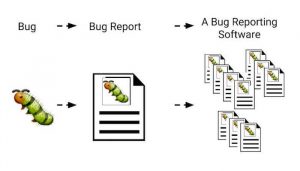
As a mobile app development company in Bangalore, having an effective Bug Tracking system is crucial to the success of your projects. A bug tracking system helps you keep track of bugs and issues in your mobile apps, prioritize fixes, and ensure a high-quality end product. The tools are also known as tracking systems or bug logs. Bug tracking aims to help developers, through more efficient work, reduce the time spent developing software products for clients. Many different types of bug tracking systems are available that vary in their functionality, ease of use, scalability, and cost with respect to the type of project.
What is a bug?
A bug is any mistake in the programming or design of an app that causes problems to users, like crashing apps or displaying wrong information on the screen. A bug can be a single piece of code, a line of code, or even a paragraph that results in the application displaying an error.
Your bug tracking system shouldn’t drive your development team. It should only help them write better apps. You need to have a second person in your team who is seen as the head of that particular project and whose job is to ensure all the rules and procedures are followed appropriately. Having a good bug tracking system on your side will help you keep track of changes and issues and help you create better apps thanks to the framework created by your tracking system.

The Importance of Bug Tracking Systems in Mobile App Development
A bug tracking system is a vital tool for any mobile app development project. It helps developers identify, track, and resolve issues that may arise during development. By implementing a bug tracking system, teams can:
- Improve the overall quality of the app
- Reduce development time and costs
- Enhance collaboration and communication among team members
- Streamline the development process
Steps to implement the robust bug Tracking system
1. Define Clear Roles and Responsibilities
The first step to creating an effective bug tracking system is to define clear roles and responsibilities for your team members. You’ll want to designate developers, testers, and product managers responsible for identifying, logging, prioritizing, and fixing bugs. Make sure each team member understands their role in the bug-tracking process.
2. Choose the Right bug tracking system Tool
Many bug-tracking tools are available, so you’ll want to evaluate options to find one that suits your needs. Some of the most popular tools for mobile app development teams include Jira, Bugzilla, MantisBT, and GitHub Issues. Consider factors like ease of use, integration with other tools, customization options, and pricing. The tool you choose will be essential to streamlining your bug-tracking process.
3. Establish a Standard Bug Reporting Process
Once you have the right tools and team roles, develop a standard process for reporting bugs. Require that all new bugs follow a specific format that includes details like:
- Bug title: A short but descriptive title
- Description: A clear description of the bug, including the exact steps to reproduce it
- Severity: The severity level (high, medium, low) based on the impact on users
- Device: The device model/OS on which the bug was found
- Media: Any screenshots, videos, or logs that could help identify the root cause
- Build version: The version of the app build in which the bug was found
4. Prioritize and Address High-Severity Bugs Quickly
Not all bugs are created equal. As bugs are reported, your team should review each new bug and assign a severity level based on its impact on users. High-severity bugs impacting the user experience should be addressed as top priorities. Medium and low-severity bugs can be addressed in subsequent sprints. Fixing bugs efficiently based on severity.

5. Conduct Regular Bug Triage Meetings
Conduct regular bug-triage meetings with your team for the most effective bug tracking. In these meetings, review new and existing bugs, re-prioritize as needed, and assign bugs to developers to be fixed. Discuss any bugs that require further investigation to determine the root cause. These meetings help ensure all high-priority bugs are addressed quickly, and no bugs slip through the cracks.
6. Verify and Close Resolved Bugs
Once a developer believes they have fixed a bug, the fix needs to be verified by a tester. The tester will review the fix on the mobile device to confirm the bug is resolved and that no new issues were introduced. If the fix is verified, the bug can be closed in your tracking tool. The bug is reopened and returned to the developer if further issues are found. This verification step is important to provide a high-quality user experience.
7. Continuously Optimize Your Process
Even with the best tools and processes in place, your bug tracking system has room for improvement. Conduct regular reviews of your bug reports to look for any trends in the types of bugs being reported. Look for ways to catch certain bug types earlier in the development process. Get feedback from your team members on what’s working well and any areas of frustration. Make any necessary changes to optimize your bug-tracking process and reduce the number of bugs in your production apps.
The Expertise of a Mobile App Development Company
India has emerged as a global hub for mobile app development, with many companies specializing in Android app development. An Android app development company in India can provide cost-effective solutions without compromising quality. They have access to a vast pool of talented developers skilled in the latest technologies and tools, ensuring your app is developed to the highest standards.
Bangalore, often called the Silicon Valley of India, is home to numerous mobile app development companies specializing in creating high-quality apps for various platforms. A mobile app development company in Bangalore like cumulations can provide you with the expertise and resources needed to create a successful app, including implementing a robust bug tracking system.

Conclusion
With a streamlined bug tracking system and continuous optimization, your mobile app development team can achieve high-quality results and happy, loyal users. Keeping track of bugs may not be the most glamorous part of app development, but it is one of the most critical factors in your success.


 +91-984-5825982 | +91-996-4689921
+91-984-5825982 | +91-996-4689921 sales@cumulations.com
sales@cumulations.com Send your requirement
Send your requirement 